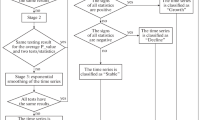Abstract
Due to the poor performance of US students in international math and science tests, many authors worry that the US lead in science is in jeopardy. A recent study by Chen and Luoh (Soc Indic Res 96: 133–143, 2010) challenged this pessimistic view by delinking test performance and labor force quality. It was found that measures such as researchers per capita or scientific journal articles per capita can better account for economic performance. Because it takes time for education and R&D to yield returns, this project replicated the preceding study using a time-lag structure. Although the results partly concur with previous findings, it is important to point out that GDP might depend on multiple variables acting together. Instead of solely focusing on reforming STEM education as partly measured by international test scores, improving the R&D infrastructure and openness in trade could also be crucial to the future of the economy.






Similar content being viewed by others
References
Bracey, G. (2009). PISA: Not leaning hard on US economy. Phi Delta Kappan, 90(6), 450–451.
Breiman, L., Friedman, J. H., Olshen, R. A., & Stone, C. J. (1984). Classification and regression trees. Monterey, CA: Wadsworth International Group.
Bureau of Labor Statistics. (2010). Employment projections: Fastest growing occupations. Retrieved from http://www.bls.gov/emp/ep_table_103.htm. Accessed 1 July 2010.
Center for International Comparisons of Production, Income and Prices. (2010). Pen World Table 6.3. http://pwt.econ.upenn.edu/php_site/pwt63/pwt63_form.php. Accessed 1 July 2010.
Chen, S. S., & Luoh, M. C. (2010). Are mathematics and science test scores good indicators of labor-force quality? Social Indicator Research, 96, 133–143.
Christensen, C. M. (2008). Disrupting class: How disruptive innovation will change the way the world learns. New York: McGraw-Hill.
Data Description Inc. (2010). Data Desk 6.2 [Computer software and manual]. Ithaca, NY: Author.
Ding, Y., Stolowy, H., & Tenenhaus, M. (2007). R&D productivity: An exploratory international study. Review of Accounting and Finance, 6(1), 86–101.
Emeagwali, N. S. (2010). National science board says US lead in STEM slipping. Techniques: Connecting Education & Careers, 85(3), 10–11.
Fielding, A. H. (2007). Cluster and classification techniques for the biosciences. New York, NY: Cambridge University Press.
Fritts, H. C., Blasing, T. J., Hayden, B. P., & Kutzbach, J. E. (1971). Multivariate techniques for specifying tree-growth and climate relationships and for reconstructing anomalies in paleoclimate. Journal of Applied Meteorology, 10, 845–864.
Hanushek, E. A. (2005, June). Why quality matters in education. Finance and Development, 15–19.
Hoerl, A. E., & Kennard, R. W. (1970). Ridge regression: Biased estimation for nonorthogonal problems. Technometrics, 42(1), 80–86.
Kannankutty, N., & Burrelli, J. (2007, June). Why did they come to the United States? A profile of immigrant scientists and engineers. National Science Foundation Info Brief, NSF07-324. Retrieved from http://www.nsf.gov/statistics/infbrief/nsf07324/. Accessed 20 June 2010.
Krus, D. J., & Fuller, E. A. (1982). Computer-assisted multicross-validation in regression analysis. Educational and Psychological Measurement, 42, 187–193.
Leshner, A. (2009, January 12). A wake-up call for science education. Boston Globe. Retrieved from http://www.boston.com/bostonglobe/editorial_opinion/oped/articles/2009/01/12/a_wake_up_call_for_science_education/. Accessed 10 October 2010.
Lev, B., & Sougiannis, T. (1996). The capitalization, amortization, and value-relevance of R&D. Journal of Accounting and Economics, 21, 107–138.
National Academy of Sciences. (2010). Expanding underrepresented minority participation: America’s science and technology talent at the crossroads. Washington, D.C.: National Academies Press.
National Science Board. (2010). Preparing the next generation of STEM innovators: Identifying and developing our nation’s human capital. Arlington, VA: National Science Foundation.
OECD. (2010a). Database: PISA 2000. http://pisa2000.acer.edu.au/. Accessed 1 July 2010.
OECD. (2010b). Database: PISA 2003. http://pisa2003.acer.edu.au/Accessed 1 July 2010.
OECD. (2010c). The high cost of low educational performance: The long run economic impact of improving PISA outcomes. www.oecd.org/dataoecd/11/28/44417824.pdf Accessed 1 July 2010.
OECD. (n.d.). Top-performer Finland improves further in PISA survey as gap between countries widens. http://www.oecd.org/document/0/0,3343,en_2649_34487_34010524_1_1_1_1,00.html Accessed 1 July 2010.
Ravenscraft, D., & Scherer, F. M. (1982). The lag structure of returns to research and development. Applied Economics, 14, 603–620.
Salzman, H., & Lowell, L. (2008, May). Making the grade. Nature, 453, 28–30. www.nature.com/nature/journal/v453/n7191/full/453028a.html. Accessed 3 July 2010.
SAS Institute. (2008). JMP 8. [Computer software and manual]. Cary, NC: Author.
SAS Institute. (2009). SAS 9.2. [Computer software and manual]. Cary, NC: Author.
United Nations. (2010). United Nations Statistical Division (UNSD) statistical databases. http://unstats.un.org/unsd/databases.htm. Accessed 1 July 2010.
Viadero, D. (2008). PISA results scoured for secrets to better science scores. Education Week, 27(17), 10.
Vilcek, J., & Cronstein, B. N. (2006). A prize for the foreign-born. Journal of the Federation of American Societies for experimental Biology, 20, 1281–1283.
World Bank group. (2010). World data bank. http://databank.worldbank.org/ddp/home.do?Step=1&id=4. Accessed 1 July 2010.
Yu, C. H. (2003). Resampling methods: Concepts, applications, and justification. Practical Assessment Research and Evaluation, 8(19). http://pareonline.net/getvn.asp?v=8&n=19. Accessed 2 July 2005.
Yu, C. H. (2007). Resampling: A conceptual and procedural introduction. In J. Osborne (Ed.), Best practices in quantitative methods (pp. 283–298). Thousand Oaks, CA: Sage Publications.
Yu, C. H. (2010). Exploratory data analysis in the context of data mining and resampling. International Journal of Psychological Research, 3(1), 9–22. http://mvint.usbmed.edu.co:8002/ojs/index.php/web/article/download/455/460. Accessed 20 September 2010.
Author information
Authors and Affiliations
Corresponding author
Rights and permissions
About this article
Cite this article
Yu, C.H., DiGangi, S. & Jannasch-Pennell, A. A Time-Lag Analysis of the Relationships Among PISA Scores, Scientific Research Publication, and Economic Performance. Soc Indic Res 107, 317–330 (2012). https://doi.org/10.1007/s11205-011-9850-5
Accepted:
Published:
Issue Date:
DOI: https://doi.org/10.1007/s11205-011-9850-5




